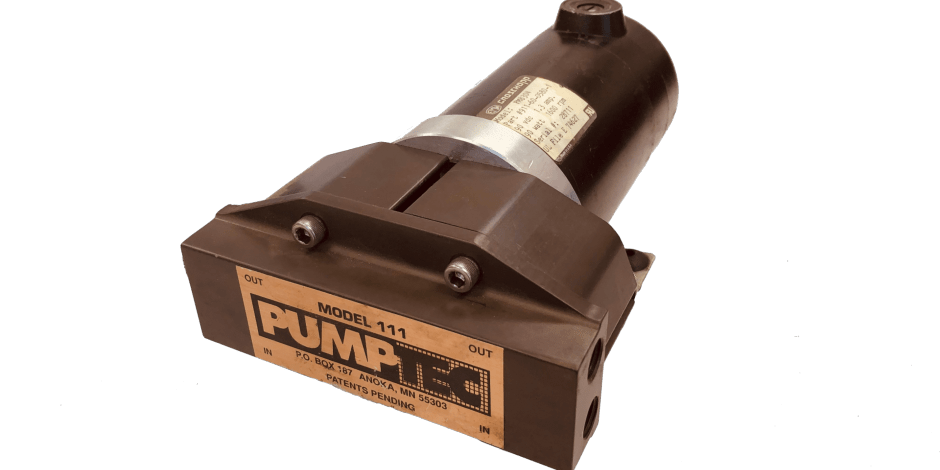The Storied History of Plunger Pumps: Then and Now

Shawn Glover, VP of Sales, Dec 13, 2022

The history of plunger pumps goes back centuries. Its invention is attributed to Sir Samuel Morland, who is credited with improving the water supply to Windsor Castle through its use. He patented his plunger pump design in 1675 which was hailed for its ability to move large amounts of water more easily than less sophisticated pumps of his day.
While the basic concept of positive displacement plunger pumps remains the same (a reciprocating rod or plunger draws fluid into an inlet valve and forces it out an outlet valve), the industry has advanced considerably in recent years. This is thanks, in part, to some of the innovations introduced by our own Pumptec engineering team. Let’s take a look.
RELATED ARTICLE: Know the Difference: Plunger Pumps vs. Piston Pumps
Introduction of Compact Plunger Pumps
As noted, plunger pumps were originally designed to transfer water at high volumes. Still today, plunger pumps are often used in wastewater treatment plants and the oil and gas industries to move hundreds or thousands of gallons per minute (GPM). As such, the pump systems can be huge.
Like many technological advances, plunger pumps became more compact and their uses expanded. Despite their smaller size, plunger pump designs changed very little up until the late 1980s. Most pumps under 1.5 horsepower were bulky and expensive, and their performance was underwhelming.
It was then that Pumptec founder Jim Cook engineered an innovative plunger pump with a smaller footprint. His first customer was a startup company that produced cleaning machines – machines that gained a lot of attention for their small size, high performance, and long-lasting durability. Pumptec grew from there and now serves multiple industries.
“These guys are smart, dependable, consistent, and honest. What more could you ask for?” Terry Schawe, Kaivac
Precise Flow and Pressure
Many pumps deliver either high flow or high pressure, but often lack precision in either regard. An advantage of compact plunger pumps is that they can be custom engineered to dispense liquids at extremely precise rates.
For example, compact pumps, like the Pumptec 113C, can have very low flow or GPM for use in the misting industry, putting out less than .25 GPM and operating at 1000 PSI.
FUN FACT: The Pumptec patented 113 Series pump was developed for the 1996 Summer Olympics held in Atlanta, Georgia to provide evaporative cooling for athletes and attendees.
Some industries demand precision to protect the health of humans and herds, such as calibrated chemical injection or metering for agriculture or dairy production. Proper flow and pressure also help ensure compliance with highly regulated industries such as pest control and lawn care.
Self-Priming Function
Pumps that are submerged in water or are below the reservoir tank are inherently self-priming. That is of little use to most commercial operators and systems that have tanks at varying heights. Self-priming functions on plunger pumps are a relatively recent technology, working against gravity to draw fluids up. Correctly designing and installing the pump with the right fixtures and properly sizing the self-priming plunger pump are critical to ensure it operates properly.
RELATED ARTICLE: Pros and Cons of Self-Priming Pumps
So Long Oil Bath Pumps
Another innovation in plunger pumps is the elimination of oil baths for commercial use. Oil bath pumps, sometimes called triplex plunger pumps, contain a reservoir of oil that splashes onto the crankshaft to provide lubrication. Triplex pumps are still commonplace today for larger applications and have their place. However, they require much more maintenance and typically cannot be tipped on their side without leaking oil.
One of the features of Pumptec pumps is that they have sealed bearings that don't leak or require replenishing of oil. This allows the pump to be used in multiple applications where oil bath pumps are impractical. They’re portable and able to be moved on and off a truck bed without concerns about it tipping over and spilling oil. Since the beginning, every Pumptec pump has featured sealed bearings.
The Transition from Gas to Electric
A major advantage of Pumptec plunger pumps is that they don’t require the use of combustible engines or fuel to operate. They can be operated using a battery or AC power. Not only do electric pumps support sustainability initiatives, they also help reduce and even out operating costs.
Of recent concern to many commercial users like soft wash technicians, portable sanitation operators, and lawn care professionals is legislation banning small off-road engines (SORE) commonly used in their equipment.
Many are concerned about having to switch out batteries multiple times each day or that electric plunger pumps simply can’t measure up to gas-powered equipment. Just as plunger pump technology has evolved through the years, so too has battery technology. When combined with a high-efficiency plunger pump, like those offered by Pumptec, an operator can go an entire day on a single charge.
WATCH THE VIDEO: Pump Industry Impact of Gas-Powered Equipment Ban
Pump Efficiency Gains
Not all types of electric pumps can boast all-day performance despite advancements in battery technology. Plunger pumps have a simpler design than most commercial pumps, resulting in less friction and energy loss. Pumptec’s patented designs operate at 93% efficiency, among the highest ratings in the market. When used with a quality motor, the combined efficiency tops out around 75%. The maximum efficiency of other commercial pump designs using the same motor will be about 20% less, which will quickly drain a battery.
RELATED ARTICLE: The Importance of High-Pressure Pump Efficiency
Beyond their inherently simpler design, engineers also need to consider plumbing configurations, pump accessories, nozzles, and a host of other design elements. That’s where the value of a pump design engineer is invaluable. They’ll be able to not only design the pump itself, but also help you determine the optimal design for the entire system to achieve the exact performance you need.
Choosing the right pump system for your equipment is a big decision that can have major consequences, either good or bad. Use our Pump Comparison Cheat Sheet below to examine features of various pumps and which type is best suited for your application.
Ready to talk to a pump engineer? We’re eager to help. Contact our pump experts today.



